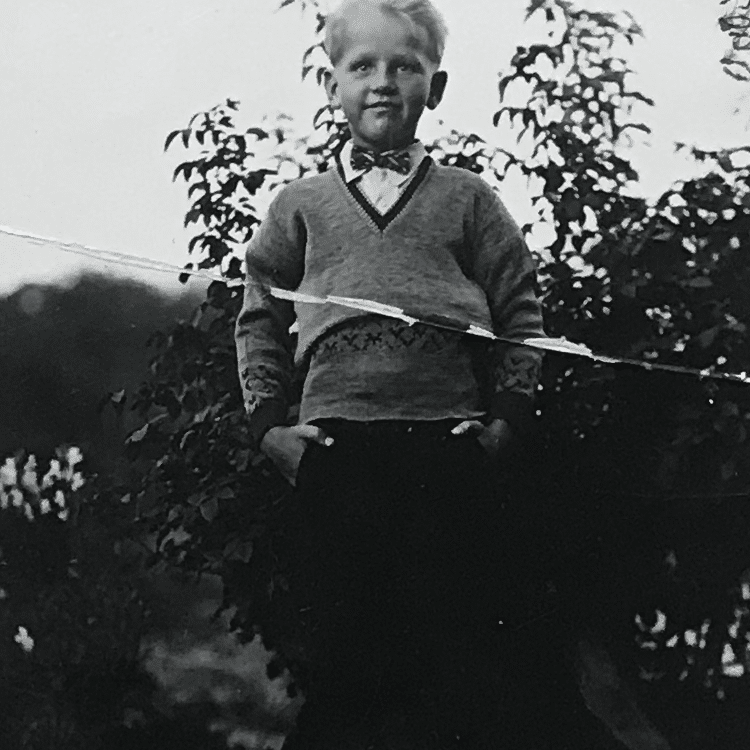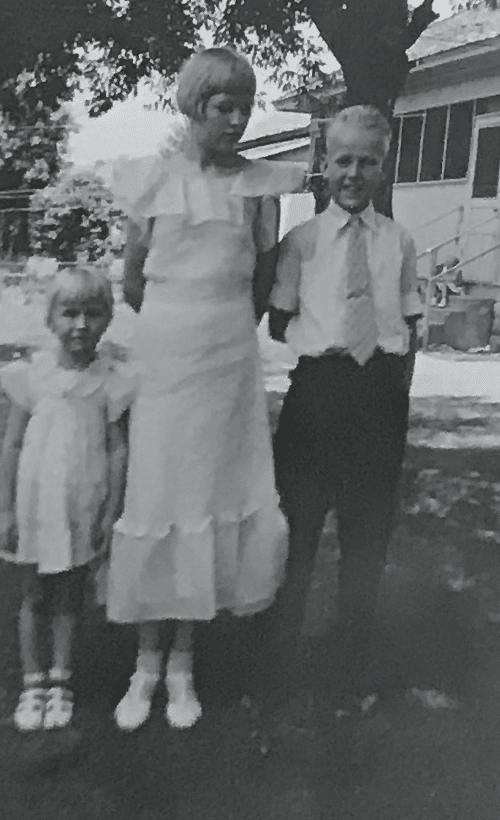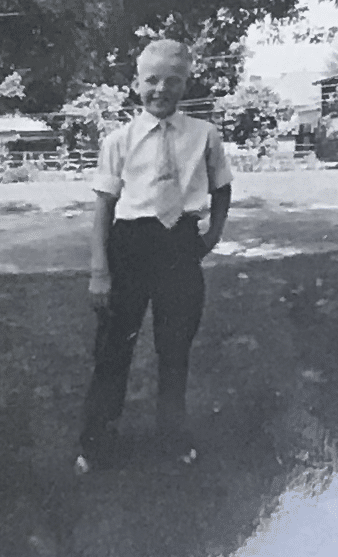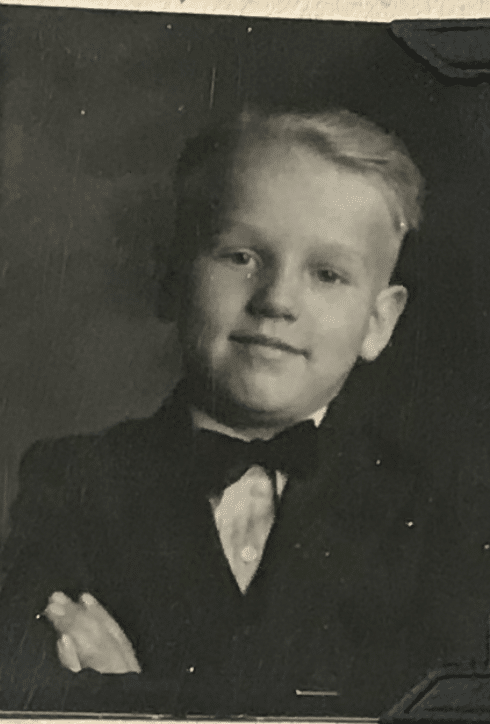The rise of conservative ideology in the 1960s and early 1970s, fueled by backlash against liberal government programs, cultural change, and environmental protection, helps explain why Joseph Ray Cox Jr.—despite his popularity and experience—lost his 1974 Congressional race in Idaho, a state that was rapidly aligning with the New Right.
Biography

J. Ray Cox. Jr.
Circa 1930

Pat, Natalie, J. Ray
Circa 1935

J. Ray Cox Jr.
Circa 1935

J. Ray Cox Jr.
Circa 1935
Joseph Ray Cox Jr. was born August 28, 1925 at 5:30 am in Ogden Utah. His mother was Nora Doxey Cox, and his father was Joseph Ray Cox. Joseph Cox Sr. was a switchman for the railroads, and worked every day of his life from 1925 until his death in 1959. Ray or J. Ray as he became known at the age of five, was a smart, talented and personable young man. He faced the hardships of the Great Depression, and recognized the desperation that comes with great poverty. He learned to find food wherever he could, even if that meant picking onions or apples from fields as he walked home from school. From his experiences of hunger, and watching his dad cut cardboard soles for his boots every morning before work, he knew he would always help those less fortunate than himself. Ray’s charisma and leadership skills began to show early on while he was attending school. J. Ray attended Lewis Junior High in Ogden Utah and then Ogden Senior High. In 1940, he gained recognition twice in the local newspaper, The Ogden Standard-Examiner. First in the March 17th edition for taking third place in a National poster contest to promote peace. [1] Then again in the December 1st edition for performing in a play. [2] The play was to occur on December 6 and 7th. He was athletic, and played basketball and baseball. In 1941, Cox’s basketball team won the Ogden City basketball crown. Ray’s athleticism would save his life in World War II.
[1] The Ogden Standard-Examiner. 1940. “These Posters are Entered In National Contest.” March 17, 1940. https://newspapers.lib.utah.edu/details?id=25925909&page=23&q=These+Posters+are+Entered+in+National+Contest&sort=date_tdt+asc%2Cparent_i+asc%2Cpage_i+asc
[2] Ogden Standard-Examiner |. 1941. “These Youngsters Bring Casaba Crown to the Lewis High School.” 2 28, 1941, 10. https://newspapers.lib.utah.edu/details?id=25932811&q=These+Youngsters+Bring+Casaba+Crown+to+Lewis+High+School&sort=rel.

J. Ray Cox. Jr.
Circa 1930

Pat, Natalie, J. Ray
Circa 1935

J. Ray Cox Jr.
Circa 1935

J. Ray Cox Jr.
Circa 1935
From the time Cox could talk, he was entertaining others. From a very early age, he showed an aptitude for music. Cox could play the piano, sing and play the saxophone. A family legend shows that he was able to teach himself to play. When asked if Cox ever took music lessons that answer was, “Nana took Grandpa to a teacher when he was young, but she said “there’s nothing I can teach him” I think that’s a sketchy story- but he didn’t have lessons. He didn’t know any classical piano pieces, and he always said Mom was a better sight reader than he was.” [3] From his daughter Katherine, “ Dad was a musical genius. He could play anything by ear, in any key, if he heard it once. Even if he hadn’t heard a song before, he could tell what key the tune was in and what chord progression was probably in play, and join in within a few measures. This talent was valuable in the Navy, He also delighted his supporters on the campaign trail with impromptu performances if there happened to be a piano at the venu.” [4] His love of music and performance followed him throughout his entire life. Even in retirement he was playing the saxophone in the Coeur d’Alene Big Band and performed for retirement communities.
As Cox grew older, people were drawn to him. Not only could he perform and play sports, he had a wonderful sense of humor. “His sense of humor was often the main thing people admired about him. He said he and his good friend often rode to school together in the friend’s vehicle, which must have been off-road capable. Maybe it was a farm truck, in agrarian Utah. They had been warned that if they were tardy one more day they would both be expelled. They sped to school, pulling up just as the bell was ringing, and drove directly up the broad front stairway to the main entrance. Dad always laughed all over again, when he told that story. Apparently they were not expelled.” [5]
[3] Cox Green, Katherine. n.d. Music Oral History.
[4] Cox Green, Katherine. n.d. Music Oral History.
[5] Cox Green, Katherine. n.d. Sense of Humor, Oral History.
Cox graduated from Ogden high school in 1943. Two days after his eighteenth birthday, he enlisted in the Navy. His leadership skills were enhanced, as he took on learning the skills of an electrician’s mate. He played saxophone in the Navy band. While stationed at Farragut Naval base in Idaho, his band played while a local seventeen year old singer performed, “Embraceable You.” From that moment on, Cox was smitten with the beautiful, talented Frances Ericksen. Since she was so young, they did not get married until he was released from duty, but the minute he got home he made his way to Idaho and married Frances on April 21, 1946. The details of their wedding were posted in the Coeur d’Alene Press and the Ogden Standard Examiner.
The young couple had plans to live in Southern California, where Ray would attend UCLA, and Frances would sing in Hollywood. It’s said that after ten minutes they realized they didn’t want to live there and moved back to Idaho. Ray was able to attend college with the G.I. Bill. He first attended Weber College, where he played baseball, then North Idaho Junior College. Ray received his Bachelor’s Degree from The University of Idaho, where he then also attended law school.

J. Ray Cox. Jr.
Circa 1930

Pat, Natalie, J. Ray
Circa 1935

J. Ray Cox Jr.
Circa 1935

J. Ray Cox Jr.
Circa 1935
The years the couple spent in Moscow, Idaho while Ray attended the University of Idaho once again show his inclination for leadership and entertaining. By this time, the couple were parents to three young children. Frances cared for them, while earning money as a singer. Ray was the student body president at every school he attended. The Spokesman Review gives the account of the election of 1952, “Joseph Ray Cox, junior law student at the University of Idaho, was elected as President of the associated students in an all-campus election.” [6] Foreshadowing his future elections, he ran under a third party ticket that wasn’t popular among the student body. The article states that he was the first student to win on a third party ticket. The University of Idaho yearbook states that he traded homework help for campaign help. He also joined the music scene and was part of the Blue Key Club, a service club, and the Bench and Bar Club, a club for future lawyers. In 1953, a craze was sweeping through colleges: panty raids. Cox had the idea to turn this fad into a fundraiser for charity.
[6] The Spokesman-Review. 1952. “Idaho Students Elect Leaders.” May 6, 1952, 6
Once out of law school, the family moved to Coeur d’Alene, Idaho, where Frances grew up. Ray opened his own law practice. Cox writes in his resume of 1962, about some of his clients he had over the years. “Some representative clients are: School Districts, Housing Commission, Youth Organizations, Estates, Auto dealer, Insurance Company, Development Company, and many private individuals. My practice has been general, and I have handled virtually all types of cases and matters, including general trial and probate work. Have also represented a number of land owners in condemnation suits brought by the State Highway Department. My work has included extensive appeal work before the Supreme Court of Idaho.” [7]
The young family, which eventually grew to include five children, enjoyed a home full of music, laughter and entertainment. Ray’s intelligence, charisma, and tenacity gained him a lucrative career, which eventually included becoming Idaho State Senator. Ray served on the Idaho Board of Education and was on numerous boards and committees in Idaho. Some included; the Kootenai Economic Development Corp, The Elks Lodge number 1254, member of the Chamber of Commerce, founding member of the YMCA, served on the committees of Judiciary and Rules Banking Insurance, and State Affairs. Cox was involved in the community of Coeur d’Alene, and was even chairman of the 4th of July Celebration.
[7] Cox, Joseph R. 1962. 1962 Resume, Resume.
J. Ray and Frances continued to live, work and serve in Coeur d’Alene for many years. As their children grew and started families of their own, it was suggested to them that they find a hobby they could do together. They landed on golf. They moved to Hayden Lake Idaho and built a home that was on the 17th fairway of the Avondale Golf Course. Ray and Frances created a home there with a swimming pool (a rarity in North Idaho), a home grown garden with the sweetest peas and raspberries, and walked the golf course every day. Their home had wall to wall windows with breathtaking views of the forests of North Idaho. They continued to sing and entertain. They joined their children, who were also musically talented many times. In 1988 with Ray on the keyboard and Frances singing, they joined their son Steve at the Post Falls Idaho Jazz Festival. Ray eventually quit smoking, a habit he had had since he was thirteen years old, and eventually stopped drinking. Their golden years were happy and joyful. Everyone who knew them could see how much love Ray and Frances had for each other. Through every success and trial, they had always loved each other.
In 1997, an article came out in The Idaho Statesman about their relationship and the ups and downs that come with a long marriage. The article reads as follows, “One October night in 1944, a pretty 17-year-old with a rich alto stepped in front of the camp band to sing “Embraceable You.” Her name was Frances Ericksen. The tenor sax player, J. Ray Cox, fell instantly in love. Stationed at Farragut Naval Center, he was training as an electrician’s mate. Three months later, Ray and Frances became engaged, and the following year, on April 21, 1946, they were married.
Now, after more than 50 years, they still perform the love songs of the ‘40s together. “I still deeply enjoy playing for her and listening to her,” says Ray Cox, a semi-retired Coeur d’Alene attorney with thinning silver hair and a performer’s ebullience. “(Her voice) moved me then and it moves me now.” When they met, Ray played both the piano and the saxophone with the Camp Gilmore Service School Band. Frances, a Coeur d’Alene High School graduate, sang for the servicemen and regularly attended Mormon Sunday School. They separated for nearly a year when Ray was shipped out to serve in the South Pacific. “It was frightening,” Frances recalls. “I think life becomes more precious when you realize there may not be a tomorrow,” Ray says.
After their wedding, the Coxes struggled through the lean years, raising three babies and subsisting on macaroni and cheese, often short on the cheese. Ray attended law school. “It seemed like the years we were sacrificing were the years that bound us together,” Ray says. Two more babies arrived. So did a Coeur d’Alene law practice and three terms in the Idaho state Senate. Then the couple hit 40. “The is-that-all-there-is? years,” Ray calls them. He lost a state attorney general’s election and was bitterly disappointed. It was the ‘60s. Their kids were rebelling, listening to rock music neither parent understood. To Ray, the indecipherable lyrics sounded like endless choruses of “Stab your dad.”
Both Ray and Frances were strong-willed, too. The Mormon Church pulled Frances in one direction, Ray’s political career and his love of parties and the occasional drink pulled him in another. They separated for a year. During that time, Frances moved to Salt Lake City to start a musical kindergarten. A friend referred her to a marriage counselor. He wanted to see them both. “I’ll be there on the next plane,” Ray said. The counselor sized them up quickly. He advised them to give each other a little leeway. Tolerate the church, he told Ray. Tolerate the parties, he told Frances. But, he told the Coxes, you’ve got to find one thing that you both enjoy that you can do together. For Frances and Ray, that became golf.
Ray had an unspectacular 20 handicap. The children were nearly grown, and now Frances had time for lessons. Soon she was beating him. The game brought them together. Between shots, they had time to share their lives. They wound up building a brick home on the 17th fairway at the Avondale Golf & Tennis Club, where they’ve lived for the past 20 years. During those years, Ray Cox lost plenty of divorce clients by advising warring couples, “If there’s a spark of love left, you should nourish it.”
The Coxes celebrated their 50th wedding anniversary last summer with a cruise on Lake Coeur d’Alene. Today, they stay close through performances with the Elks Club Dance Band, golf and a shared faith. As Mormons, they believe they’re bound together for eternity. “We’ve been happier the last two years of our marriage than we ever have,” says Frances Cox, 70, still pretty, with blue-gray eyes, reddish brown hair and rose lipstick. On a recent snowy afternoon, the Coxes flashed identical beaming grins as they cuddled on the piano bench in their living room. Then Ray played as Frances sang one of his favorites, “The Man I Love.” Ray Cox, 71, has a message for today’s 40-year-old couples: “The later years of life can be sweeter and better than you ever dreamed of. Stick it out.” [8]
[9] Etlinger, Charles. 1978. “Sunshine Mine Foam Lethal, Witness Says.” The Idaho Statesman, April 4, 1978.
Frances Cox died on May 19, 2009, with Ray following close behind her. Family and friends knew he wouldn’t want to be in this life without her. Ray died on Tuesday afternoon, on June 9 in 2009 at the age of 84. His legacy continues through his children, grandchildren and great-grandchildren. His daughter Claudia was a successful paralegal, and his great-grandson Aaron Green is attending law school, and several of his posterity are musically talented and share that talent with the world, with some playing in bands, singing, and performing in plays and musicals all over the country.
Ray was part of the “greatest generation,” the group that began life with the Great Depression, and fought in World War II. He worked tirelessly, never took anything for granted, and fiercely loved and protected his family. Ray’s legacy of music, entertainment, intelligence and humor lives on in his posterity. He accomplished many great things in his lifetime, and suffered several big defeats. From each loss, he picked himself back up, and found another way to serve his community, town and state. He was a great man.
Ray Cox singing one of his signature songs, “When the Cat Came Back”
Bibliography
Cox, Joseph R. 1962. 1962 Resume, Resume.
Cox Green, Katherine. n.d. Music Oral History.
Cox Green, Katherine. n.d. Sense of Humor, Oral History.
Neely, James T. 1997. “Spark of Love Kept Fire Burning Through Challenges as Well as Good Times.” The Idaho Statesman, 1997.
The Ogden Standard-Examiner. 1940. “These Posters are Entered In National Contest.” March 17, 1940. https://newspapers.lib.utah.edu/details?id=25925909&page=23&q=These+Posters+are+Entered+in+National+Contest&sort=date_tdt+asc%2Cparent_i+asc%2Cpage_i+asc.
The Ogden Standard- Examiner. 1940. “They’ll Promenade Before Lewis Schoo’s Footlights.” December 1, 1940. https://newspapers.lib.utah.edu/details?id=25930995.
Ogden Standard-Examiner |. 1941. “These Youngsters Bring Casaba Crown to the Lewis Highschool.” 2 28, 1941, 10. https://newspapers.lib.utah.edu/details?id=25932811&q=These+Youngsters+Bring+Casaba+Crown+to+Lewis+High+School&sort=rel.
The Spokesman-Review. 1952. “Idaho Students Elect Leaders.” May 6, 1952, 6.